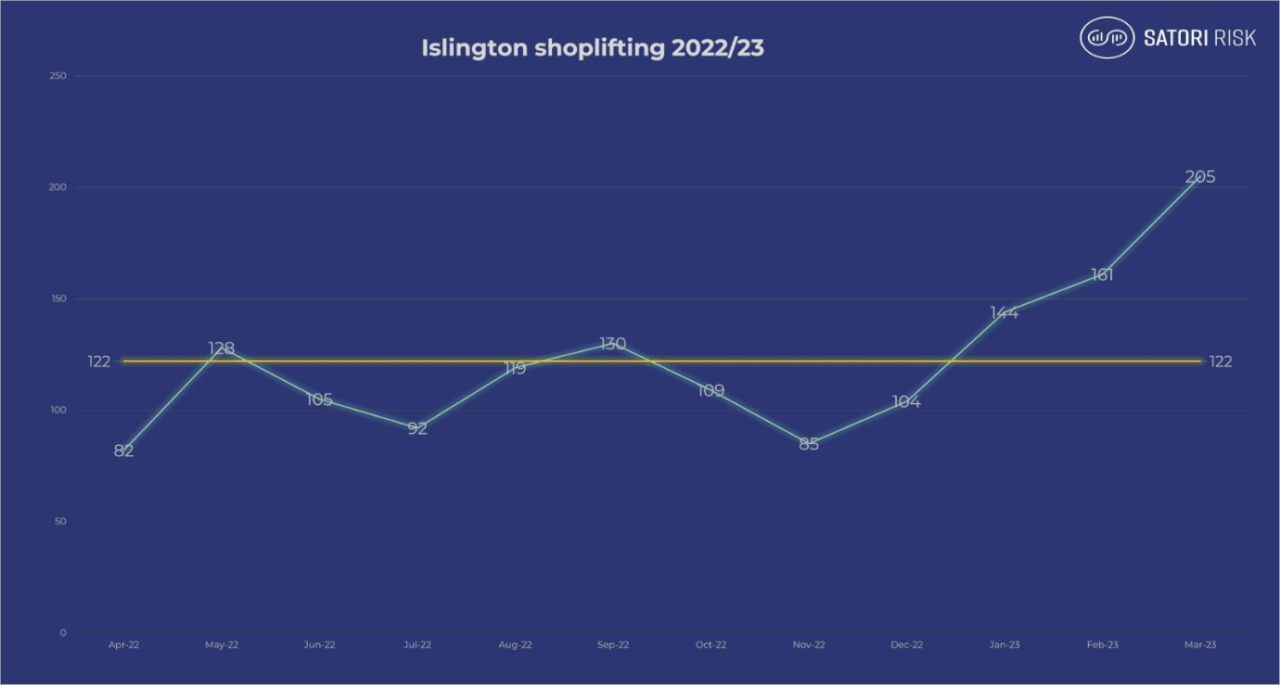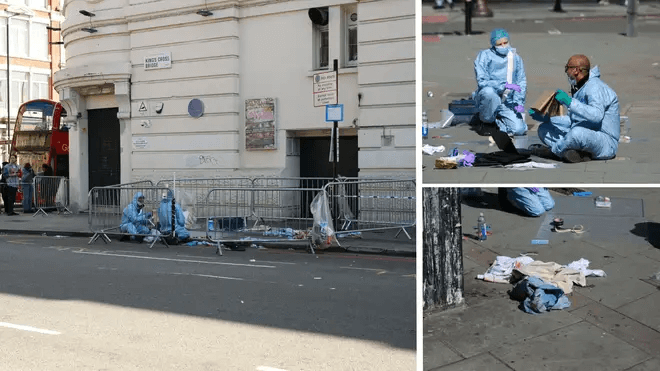Islington, a lively borough in the heart of London, is famous for its diverse community and cultural heritage. But what about crime? Is Islington a safe place to be? In this article, we’ll dig deep into Islington’s crime rate to give you a clear picture. We’ll analyse crime statistics, look at factors that affect crime rates, consider how people perceive safety, and discuss ways to make Islington even safer. So let’s dive in and find out if Islington is a secure place to live!
Shoplifting in Islington
Background
Met Police data reveals that shoplifting in Islington has sharply increased by 40% in one year. The sharp rise continues to increase, with November 2022 shoplifting figures at 85, rising to over 200 incidents in March 2023.

Analysis
Businesses should ensure that an appropriate level of security, both physical and non-physical (cameras, access, locks, and staff training), is maintained and adhered to at all times. Staff should be aware that physical altercations with a live theft offence can increase the risk of the offence escalating into a more violent incident and should always report incidents to the relevant authorities immediately.
According to the crime survey from the BRC, retail crime cost businesses £1.76 billion in 2022. £953 million was lost due to theft and shoplifting in 8 million reported incidents. Theft from retail premises can occur at several levels, with the threat actors varying in profile.
Targeted criminals typically go after conspicuously expensive items such as watches and luxury retail from higher-end outlets. This is often done in gangs, as has already been witnessed at Harrods and Harvey Nichols in London in 2023. However, large volumes of goods being stolen from British retail outlets stem from the economically driven need for certain everyday items resulting from a downturn in purchasing power, primarily affecting the lower end of the economy.
Social media chatter and video footage clearly depict gangs targeting electronics and watches in broad daylight during opening hours at retail outlets, shopping malls, and supermarkets. They often employ smash-and-grab techniques to dislodge display items from their mounts. Moreover, they frequently enter shops as a group of 4 or 5, swiftly gather high-end items from shelves, and depart within the span of one minute.
It is advisable for businesses to continually adapt their security procedures to changing economic factors, which can impact the levels and severity of acquisitive crimes in retail spaces. This adaptation is crucial considering how it may affect the health and well-being of staff who are under the duty of care of their employer.
How to Prevent Shoplifting
To effectively prevent shoplifting, retailers need to take a comprehensive approach that includes proactive measures and employee training. Here are some strategies to consider:
Store layout and design
Designing the store layout with shoplifting prevention in mind can help deter theft. Placing high-value or easily stolen items near checkout counters or in well-monitored areas makes it harder for potential shoplifters to go unnoticed.
Staff training and awareness
It’s crucial to educate and train employees on shoplifting prevention techniques. Staff should be familiar with common shoplifting behaviours, such as loitering, nervousness, or unusual bag sizes. Encouraging a vigilant and observant staff can help identify potential shoplifting incidents.
Surveillance systems
Installing surveillance cameras throughout the store, especially in high-risk areas like entrances, exits, and aisles, can deter shoplifters and assist in identifying them. Visible signs indicating the presence of surveillance can further discourage potential thieves.
Visible signs and deterrents
Displaying signs warning against shoplifting and clearly stating the store’s commitment to prosecuting offenders can effectively prevent theft. Additionally, using physical deterrents like anti-theft tags or locks on high-value merchandise can make it more challenging for shoplifters to steal.
Please note that the above text has been edited for ease of reading and improved flow.
Knife Crimes in Islington
Background
Two males in their twenties have been stabbed after an unknown offender went on a stabbing spree inside the Scala nightclub in King’s Cross at approximately 0500 on 29/4/2023. Neither victim sustained life-threatening injuries. The offender has not been apprehended.

Analysis
Between April 2022 and March 2023, 13,325 knife-related crimes across London were reported to the Metropolitan Police Service. This represents a 16.8% increase from the 12 months prior. Of all these knife offences, a quarter caused injury to the victim (3,599), and only 492 attacks were associated with a robbery, indicating a larger share of targeted gang-related disputes.
Of the victims injured by a knife, just under half were under the age of 25. The particular increase in possession of blade or point offences highlights that this offence type now accounts for a bigger proportion of knife and offensive weapon offences. In the year to March 2023, possession of blade or point offences accounted for around two-thirds (67%) of knife and offensive weapon offences dealt with, compared to 56% in the year ending March 2022.
Tips for London Businesses
When assessing the risk to London Business for knife crimes and the advisory measures to protect staff well-being, understanding the movements and trends of human capital as people navigate the city during weekdays and at weekends is important. The majority of London knife attacks happen during nighttime hours and at weekends, indicating a high likelihood that victims are targeted in or around nighttime economy venues, hospitality venues where alcohol is sold, and the secondary businesses and venues that support people using these services.
This can include food retailers and the transport network. London businesses are advised to ensure that staff are aware of the presence of knives on London’s streets and the volume of knife crime used outside of acquisitive motivation for goods, such as robbery. With personal targeted attacks taking place, it is difficult to personally mitigate against becoming involved either as a bystander or witness or a secondary victim.
Personal Safety Measures
For personal safety, staff should display vigilance and caution for surroundings and demonstrate situational awareness in crowded spaces late at night where alcohol has been consumed, and young males are present. The frequency of violent crime may indicate that offending individuals are becoming more emboldened and less wary of potential consequences.
Conclusion
Despite a number of widely published recent offences being reported as unmotivated, ‘random attacks’, members of the public remain at low risks of these types of offences, with knife crime predominantly remaining a gang-related crime.




